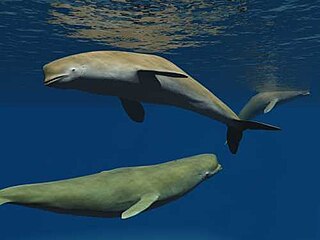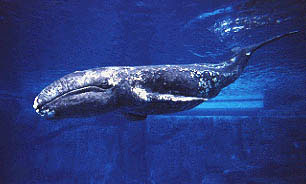 W
WArchaebalaenoptera is a genus of extinct rorqual known from late Miocene to Pliocene-age marine deposits of the Netherlands, northern Italy, and Peru.
 W
WAustralodelphis mirus is an extinct Pliocene dolphin. A. mirus is known from fossils found in the Sørsdal Formation, Mule Peninsula, Vestfold Hills, East Antarctica. The genus has been described as an example of convergent evolution with beaked whales.
 W
WBalaenoptera bertae is an extinct species of baleen whale that lived from 3.35–2.5 Mya during the Pliocene. It lived in the San Francisco Bay Area's Purisima Formation, which, during the early to middle Neogene, held a diverse assembly of cetaceans. The species was discovered in 2013.
 W
WBalaenotus is an extinct genus of cetaceans from the Pliocene of Belgium.
 W
WBalaenula is an extinct genus of cetacean.
 W
WThe blunt-snouted dolphin is a prehistoric pilot whale known from a single specimen, consisting of a partial rostrum, partial maxilla, partial premaxilla, and partial vomer. The fossil was discovered by Albert Hoekman on board a fishing trawler in the North Sea in 2008 and described in 2010 by Klaas Post and Erwin J.O. Kompanje. The blunt-snouted dolphin is believed to have had a balloonlike structure atop its rostrum and is estimated to have lived during the middle Pliocene to early Pleistocene.
 W
WBohaskaia is an extinct genus of beluga-like odontocete cetacean known from the Early Pliocene of Virginia and North Carolina, United States. It was first named by Jorge Vélez-Juarbe and Nicholas D. Pyenson in 2012 and the type species is Bohaskaia monodontoides.
 W
WCetotheriophanes is an extinct rorqual from the late Pliocene (Piacenzian) of northern Italy.
 W
WEschrichtiidae or the gray whales is a family of baleen whale with a single extant species, the gray whale. The family, however, also includes three described fossil genera: Archaeschrichtius and Eschrichtioides from the Miocene and Pliocene of Italy respectively, and Gricetoides from the Pliocene of North Carolina. The names of the extant genus and the family honours Danish zoologist Daniel Eschricht.
 W
WEschrichtioides is an extinct genus of eschrichtiid known from the early Pliocene of northern Italy. Its type species, E. gastaldii, had a complex taxonomic history, starting as a cetothere, then as an extinct balaenopterid, before being finally recognized as a relative of the gray whale.
 W
WHemisyntrachelus is an extinct genus of cetacean.
 W
WIdiocetus is a genus of extinct cetaceans of the family Balaenidae.
 W
WKentriodontidae is an extinct family of odontocete whales related to modern dolphins. The Kentriodontidae lived from the Oligocene to the Pliocene before going extinct.
 W
WKogia pusilla is an extinct species of sperm whale from the Middle Pliocene of Italy related to the modern day dwarf sperm whale and pygmy sperm whale. It is known from a single skull discovered in 1877, and was considered a species of beaked whale until 1997. The skull shares many characteristics with other sperm whales, and is comparable in size to that of the dwarf sperm whale. Like the modern Kogia, it probably hunted squid in the twilight zone, and frequented continental slopes. The environment it inhabited was likely a calm, nearshore area with a combination sandy and hard-rock seafloor. K. pusilla likely died out due to the ice ages at the end of the Pliocene.
 W
WOdobenocetops is an extinct genus of small toothed whale known from Peru and Chile. Its fossils are found in Neogene-aged marine strata dating from the Tortonian to the Zanclean. It had two tusks, and, in some fossils, one tusk was longer than the other.
 W
WOrcinus citoniensis is an extinct species of killer whale identified in the Late Pliocene of Italy and the Early Pleistocene of England. It was smaller than the modern killer whale, 4 m (13 ft) versus 7 to 10 m, and had around 8 more teeth in its jaw. It may have resembled the modern killer whale in appearance, and could represent a transitional species between the modern killer whale and other dolphins. O. citoniensis may have hunted large fish and squid in pods, and coexisted with other large predators of the time such as the orcinine Hemisyntrachelus and the extinct shark Otodus megalodon.
 W
WOrcinus paleorca is an early species of killer whale from the Middle Pleistocene of Japan known only from a single tooth fragment.
 W
WParapontoporia is an extinct genus of dolphin that lived off the Californian coast from the Late Miocene until the genus' extinction during the Pliocene.It is related to the possibly extinct Baiji.
 W
WProtororqualus is a genus of extinct rorqual from the late Pliocene of Mount Pulgnasco, Italy.
 W
WSemirostrum ceruttii is an extinct porpoise that lived between 5 and 1.5 million years ago (Ma), during the Pliocene epoch. The species is highly distinctive due to the extremely long symphysis on the lower jaw, reaching lengths of 85 centimeters (33.46 inches), while that of a modern porpoise are 1–2 centimeters (0.39–0.79 inches) long. The main hypothesis regarding its use is that it probed along the sediment in the murky estuaries and shores of what is now California in search of food, which would easily be scooped up the symphysis and into the jaws. The etymology of the name means "half beak", referring to the upper jaw being half the length of the lower.